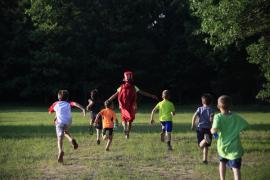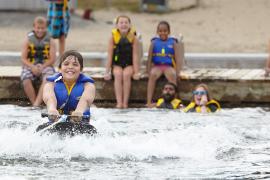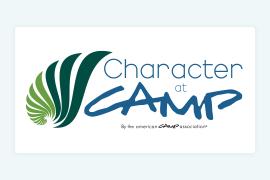Camp Twin Lakes (CTL) serves campers who have medical illnesses, disabilities, and other life challenges at two year-round camp locations in Georgia. CTL operates as a partner model camp, serving over 60 partner organizations each year. CTL’s partners are various types of nonprofit organizations who bring the populations that they serve to CTL’s facilities for camping programs.
During summer 2020, Camp Twin Lakes transitioned to virtual summer camp in light of the coronavirus pandemic and reopened at 60 percent capacity for summer 2021. In the following article, they detail their team’s strategic initiative to create a process for continuous improvement.
Camp Twin Lakes is a participant in the Camp Program Quality Initiative’s Community of Practice and, alongside eight other camp participants, has been awarded the 2022 Eleanor P. Eells Award for Research and Evaluation in Practice. Click here for more information on this project.
Theory of Continuous Improvement
Let’s be real, spreadsheets full of data are not the reason you wanted to get into a career in the camping industry. It might actually be one of the reasons you avoided some other careers. And I would agree — sunshine, archery, and days at the lake are all more enjoyable than working with data. But I want to show you today how Camp Twin Lakes has used data collection to impact campers in a deeper way. And impacting campers is something I know you care about.
Once you’ve sent a survey and downloaded the results, the numbers in a spreadsheet are data points that reflect your camping program. And in that state, the data isn’t useful to you. Organizations need systems for processing and transforming this data into information that can inform your team. An organization can collect a lot of data and have very little information. But having a little bit of data can translate into a lot of information, if the process of transforming the data is very intentional.
In 2019, Camp Twin Lakes developed the Camper Outcomes Framework and collected data on our four outcomes during virtual camp 2020. This helped us solidify the program goals and survey questions. Next, we needed to create a system to successfully utilize the information provided by the data collected. During summer 2021, we implemented a full-scale, ongoing continuous improvement effort for all programs.
Data Collection Methodology
Before we jump into our process, let’s look at the intentionality behind our data collection effort.
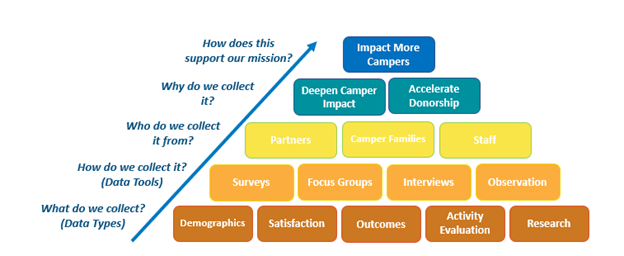
This pyramid was designed to help the Camp Twin Lakes team and stakeholders understand the purpose of data collection. The bottom three rows of our pyramid describe how we get the data. Demographic data helps with grant applications and DEI initiatives. Satisfaction data gives feedback on the facility, food services, and the overall camp experience. Outcomes data gives evidence of the change in behavior, knowledge, or skill of a participant. Activity evaluation is important for measuring the effectiveness of your program. And finally, research attempts to discover a relationship between two variables, and it is generally used to generate knowledge for camping programs beyond your own. All of this data can be collected in multiple ways. Camp Twin Lakes utilizes surveys for satisfaction and outcomes data. Focus groups and interviews are used to go deeper and understand more details around someone’s experience. They allow for follow-up questions and brainstorming, while survey questions are more surface level.
The top two rows of the pyramid describe the purpose behind CTL’s data collection, analysis, and improvement process. The team invests time and resources into this work because this data allows for program improvement and, subsequently, deeper camper impact. Next, this work empowers the development team with stories, quotes, and outcomes data to effectively explain our impact to donors. This leads to recruitment of new donors and higher retention of existing donors. Finally, this data also empowers our leadership team to build relationships with universities, which helps with staff and camper recruitment. Because of this effort, the CTL team improves the impact on campers and raises more money from donors, so more campers can come to camp for a life-changing experience.
During summer 2021, CTL surveyed three primary stakeholders and collected program quality data. Let’s look at each process in more detail.
Campers
Campers are our most important stakeholders. We want their voice to drive program change and help us improve the overall camp experience. Campers are asked satisfaction questions about their favorite activities and how safe they felt at camp. They are also asked specific outcomes questions to measure how much they have grown at camp in accordance with the camper outcomes framework. These scores are compiled into reports (summer sample report below) with demographic data and sent to partner organizations within two weeks of the final day of programming. This report can also be sent to donors, board members, and staff to tell the story of the impact that happens during the camp program.
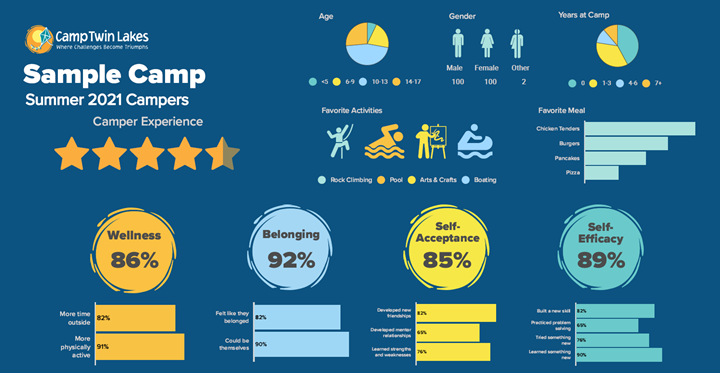
Summer Staff
Summer staff complete a pre-summer demographics survey. This allows CTL to look for trends in successful summer staff members, so our recruiting team can identify effective future staffers. They also complete a post-training survey, so the program team can make effective changes for future summers. Finally, summer staff are surveyed at the end of summer to describe how they’ve grown throughout their experience (in other words, outcomes!).
Partner Organizations
Camp Twin Lakes partners with other nonprofit organizations to put on the camp program. Each week of the summer is a collaboration between CTL and partner staff to serve a unique population of campers. Because of this, these partner organizations fill out a survey on their collaboration with CTL. They can give feedback on things like dining, housekeeping, grounds, activity equipment, program schedule, and summer staff. As our primary customer, CTL seeks to satisfy the needs of these stakeholders and continue to grow these partnerships to serve even more campers together.
Volunteers
Camp Twin Lakes surveys all the incredible volunteers that come and serve our campers. Volunteer recruitment and retention are key initiatives for our organization, so it is important to understand the volunteer experience and work on improving it. CTL asks volunteers about the effectiveness of their training, communication clarity, logistics during the week, and how they themselves have grown because of their experience (more outcomes!). These results help the staff team recruit new volunteers and create a meaningful experience.
Program Quality Improvement
The last piece of data collection that occurred in summer 2021 was activity observation for program improvement. CTL participated in the Camp Program Quality Initiative (referenced here) with the ACA to develop a new program quality tool. This data was used for in-service trainings of our program staff throughout the summer. Data gathered from this tool are also currently being used to update programs in the off-season for greater program quality.
Processing Data & Creating Insights: During Summer
As you can see, there is a lot of data being collected. Because of this, our team needed to create a process for capturing insights throughout the busy summer and then fully processing the results post-summer.
In previous years, the CTL staff team waited until the end of the summer to review all the data collected. In summer 2021, we changed this to review data weekly so that improvement could be made throughout the summer. Because everyone is busy juggling competing priorities, the team agreed to just one mid-week meeting to review data results. The purpose of this meeting was to utilize survey data to make quick adjustments. The information is summarized and presented with the emphasis on quick wins and needed follow-up. Follow-up could include further inquiry into concerning or interesting answers to survey questions or checking in on a summer staffer who said they were feeling burned out. Quick wins could include housekeeping feedback, food service meal selection, successful activity areas, and evening program logistics. Consolidating the data review process to these quick touch points allowed for managing the craziness of the summer schedule while prioritizing continuous improvement.
Although our team learned about ways to improve every week, a couple of key insights stand out. First, collecting information on the same topic from different stakeholders allows for better problem solving. For example, we can look at a volunteer counselor’s survey compared to their campers’ surveys to gain insight into the cabin’s experience. And for dining feedback, we can compare campers, volunteers, and staff responses to understand at a deeper level how to improve. Our team realized that having multiple points of view is valuable when they are trying to make changes. The second key insight from the summer was that the typical follow up action after one negative data point led to another question. It is rare to find that something isn’t working and know exactly how to change it. So a negative comment leads our team to asking someone a follow-up question, or including a more detailed question in future surveys. This process iterates on itself, leading to continual improvement.
Processing Data & Creating Insights: Post-Summer
If quick wins and follow-ups occur regularly during the summer, then post-summer can be focused on higher level data analysis and reflection. As expected, the data is consolidated, summarized, and reported to board members, donors, and grant funders. But the real work happens within the staff team to look at the results and work on improving the program. Over the course of several weeks, our program team has multiple meetings to review, discuss, and analyze the results. This time is an investment in the entire next year of program development and improvement. The information gathered from collecting data, finding quick wins, and analyzing larger trends provides every camp staff person the opportunity to make more informed decisions with resource allocation, time investment, and prioritization over the course of the next year. Ultimately our team is changing data points into deeper camper impact. We know there is more work to do to improve this process, but the impact on our organization has already been enormous.
Your Camp
If you want to start collecting data at your camping organization, I recommend organizing a meeting with your program team and asking three questions: First, if we were to improve our program, what would we do? Second, what information would we need to know to evaluate whether or not our improvements were working? And finally, what would need to change to create a culture of continuous improvement here? This kind of brainstorming session helped the Camp Twin Lakes team figure out what kinds of questions we needed to include on our surveys. It also identified roadblocks related to our culture that needed to be addressed. When you are ready, survey a small sample size of participants with only three to four questions. Collect and analyze the survey results and be intentional about transforming that data into information. Create program change based on that information. And then you’ve done it. You are in the process of continuous improvement. So keep it going. Do the work. And impact more campers!
Michelle Bevan is the Project Manager for Research and Outcomes at Camp Twin Lakes. She manages CTL’s program quality improvement and the research and outcomes initiative that demonstrates the impact of camp. Michelle will speak on this topic in more detail at ACA National in 2022.
Photo courtesy of Many Point Scout Camp in Ponsford, Minnesota
The views and opinions expressed by contributors are their own and do not necessarily reflect the views of the American Camp Association or ACA employees.

